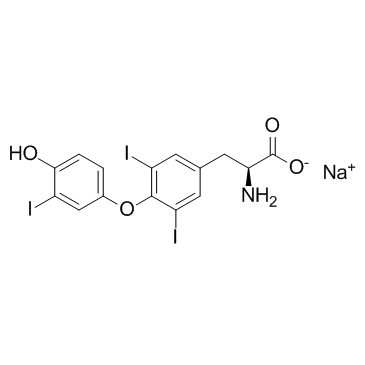3,3'',5-Triiodo-L-thyronine Sodium Salt

3,3'',5-Triiodo-L-thyronine Sodium Salt structure
|
Common Name | 3,3'',5-Triiodo-L-thyronine Sodium Salt | ||
|---|---|---|---|---|
| CAS Number | 55-06-1 | Molecular Weight | 672.955 | |
| Density | N/A | Boiling Point | 563.5ºC at 760 mmHg | |
| Molecular Formula | C15H11I3NNaO4 | Melting Point | 205 °C (dec.)(lit.) | |
| MSDS | USA | Flash Point | 294.6ºC | |
|
Enhancement of lipid peroxidation and its amelioration by vitamin E in a subject with mutations in the SBP2 gene.
J. Lipid Res. 56 , 2172-82, (2015) Selenocysteine (Sec) insertion sequence-binding protein 2 (SBP2) is essential for the biosynthesis of Sec-containing proteins, termed selenoproteins. Subjects with mutations in the SBP2 gene have decreased levels of several selenoproteins, resulting in a comp... |
|
|
Generation of functional cholangiocyte-like cells from human pluripotent stem cells and HepaRG cells.
Hepatology 60(2) , 700-14, (2014) Cholangiocytes are biliary epithelial cells, which, like hepatocytes, originate from hepatoblasts during embryonic development. In this study we investigated the potential of human embryonic stem cells (hESCs) to differentiate into cholangiocytes and we repor... |
|
|
Thyroid hormones enhance the biomechanical functionality of scaffold-free neocartilage.
Arthritis. Res. Ther. 17 , 28, (2015) The aim of this study was to investigate the effects of thyroid hormones tri-iodothyronine (T3), thyroxine (T4), and parathyroid hormone (PTH) from the parathyroid glands, known to regulate the developing limb and growth plate, on articular cartilage tissue r... |
|
|
Convergent functional genomics of oligodendrocyte differentiation identifies multiple autoinhibitory signaling circuits.
Mol. Cell. Endocrinol. 29 , 1538-53, (2009) Inadequate remyelination of brain white matter lesions has been associated with a failure of oligodendrocyte precursors to differentiate into mature, myelin-producing cells. In order to better understand which genes play a critical role in oligodendrocyte dif... |
|
|
Primary epithelial cell models for cystic fibrosis research.
Methods Mol. Biol. 742 , 285-310, (2011) When primary human airway epithelial (hAE) cells are grown in vitro on porous supports at an air-liquid interface (ALI), they recapitulate in vivo morphology and key physiologic processes. These cultures are useful for studying respiratory tract biology and d... |
|
|
Pharmacological inhibition of Polo-like kinase 1 (PLK1) by BI-2536 decreases the viability and survival of hamartin and tuberin deficient cells via induction of apoptosis and attenuation of autophagy.
Cell Cycle 14(3) , 399-407, (2015) The mechanistic target of rapamycin complex 1 (mTORC1) increases translation, cell size and angiogenesis, and inhibits autophagy. mTORC1 is negatively regulated by hamartin and tuberin, the protein products of the tumor suppressors TSC1 and TSC2 that are muta... |
|
|
Toxic effect of blood components on perinatal rat subventricular zone cells and oligodendrocyte precursor cell proliferation, differentiation and migration in culture.
J. Neurochem. 109 , 1285-99, (2009) The germinal matrix of human brain gives rise to oligodendrocytes and astrocytes after mid-gestation. Hemorrhage in the germinal matrix of premature infants is associated with suppressed cell proliferation. We hypothesize that soluble blood constituents have ... |
|
|
High content screening of cortical neurons identifies novel regulators of axon growth.
Mol. Cell. Neurosci. 44 , 43-54, (2010) Neurons in the central nervous system lose their intrinsic capacity for axon regeneration as they mature, and it is widely hypothesized that changes in gene expression are responsible. Testing this hypothesis and identifying the relevant genes has been challe... |
|
|
Primary human bronchial epithelial cells grown from explants.
J. Vis. Exp. , (2010) Human bronchial epithelial cells are needed for cell models of disease and to investigate the effect of excipients and pharmacologic agents on the function and structure of human epithelial cells. Here we describe in detail the method of growing bronchial epi... |
|
|
Wnt/beta-catenin signaling is required for CNS, but not non-CNS, angiogenesis.
PLoS Pathog. 106 , 641-646, (2009) Despite the importance of CNS blood vessels, the molecular mechanisms that regulate CNS angiogenesis and blood-brain barrier (BBB) formation are largely unknown. Here we analyze the role of Wnt/beta-catenin signaling in regulating the formation of CNS blood v... |